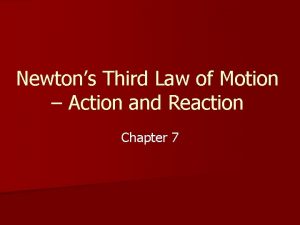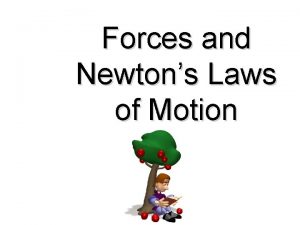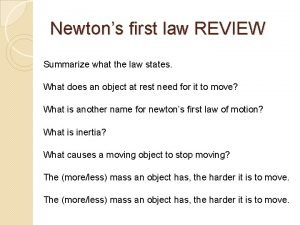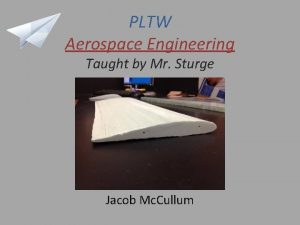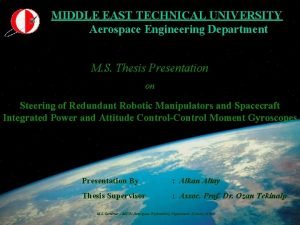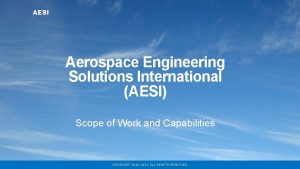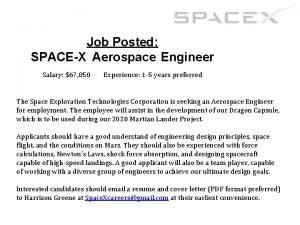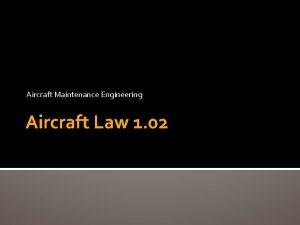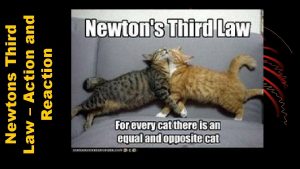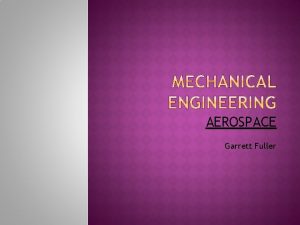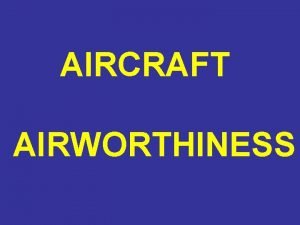Newtons Law Aircraft Action and Reaction Aerospace Engineering










- Slides: 10

Newton’s Law Aircraft Action and Reaction Aerospace Engineering © 2011 Project Lead The Way, Inc.

Newton’s Laws of Motion Review of Newton’s Laws • Law of inertia: Object in state of rest or uniform motion will continue unless acted upon by another force • Acceleration of an object is proportional to net force acting on object and inversely proportional to object’s mass (F = ma) • For every action force, there is an equal and opposite reaction force

Newton’s Third Law • In Principles of Engineering you learned that forces act and react within structures • Aircraft are acted upon by forces – Thrust and lift forces shown below

Newton’s Third Law Lift • Four forces on airplane 1. 2. 3. 4. Weight Lift Drag Thrust Drag Weight • Aircraft is in steady flight when all forces are balanced • Aircraft accelerates in direction of strongest force when not balanced

Weight • All mass of aircraft act toward center of Earth – Aircraft frame – Fuel: Decreases during flight – Payload: Passengers and cargo • Weight must be counteracted and balanced Weight

Lift • Opposes weight • Lift must equal weight for straight and level flight • Unbalanced lift and weight cause a body to ascend or descend • Lift is generated by air movement over wings Lift

Drag • Force that resists aircraft motion • Acts opposite of aircraft motion Drag

Thrust • Must equal drag for straight and level flight • Unbalance of drag and thrust causes slower or faster velocity • Propulsion system produces thrust Thrust

Newton’s Third Law of Motion • For every action force, there is an equal and opposite reaction force • Aircraft is in steady flight when all forces are balanced • Aircraft accelerates in direction of strongest force

References Microsoft, Inc. (n. d. ). Clip art. Retrieved from http: //office. microsoft. com/en-us/clipart/default. aspx National Aeronautics and Space Administration (2009). Retrieved from http: //www. grc. nasa. gov/WWW/K 12/airplane/ Navigation. In Jeppesen Private pilot: Guided flight discovery (pp. 9 -20 – 9 -46). (2007). Englewood, CO: Jeppesen
 According to the third law of motion action and reaction
According to the third law of motion action and reaction Newton's laws
Newton's laws According to the third law of motion, action and reaction
According to the third law of motion, action and reaction Newton's first law of motion statement
Newton's first law of motion statement Newton's first law and second law and third law
Newton's first law and second law and third law Newton's first law
Newton's first law Pltw aerospace engineering
Pltw aerospace engineering Metu aerospace engineering
Metu aerospace engineering Aerospace engineering solutions
Aerospace engineering solutions Phystech international
Phystech international Astronaut salary spacex
Astronaut salary spacex
